An IoT-Enabled Sensing Device to Quantify the Reliability of Shared Economy Systems Using Intelligent Sensor Fusion Building Technologies
Abstract
1. Introduction
2. Literature Review
2.1. Technology Applications in Smart Cities
2.2. Shared Economy Systems
2.3. Indoor Environmental Assessment
2.4. Research Need and Knowledge Gap
3. Methodology
3.1. Identification and Selection of Indicators
3.2. Development of a Sensing Device
3.2.1. Sensor Selection
3.2.2. Calibration of Sensors
3.2.3. Data Fusion, Sensor Integration, and Programming
3.2.4. IoT Cloud Web Server Development
3.3. Development of a Reliability Index
3.3.1. Survey Development
3.3.2. Weight Calculation
3.3.3. Reliability Index
3.3.4. Publishing the RI to Cloud
3.4. Dynamic Pricing Model
3.5. Real-World Implementation
4. Results and Analysis
4.1. Development of IoT-Enabled Device
4.2. Survey Results
4.2.1. Respondents’ Demographics
4.2.2. Importance of Indicators
4.3. Graphical User Interface
4.4. Use of the IoT-Enabled Device
5. Discussion and Contributions
6. Conclusions
Author Contributions
Funding
Data Availability Statement
Conflicts of Interest
References
- United Nations. World Urbanization Prospects. The 2014 Revision; Department of Economic and Social Affairs: New York, NY, USA, 2015. Available online: http://esa.un.org/unpd/wup/Publications/Files/WUP2014-Report.pdf (accessed on 11 May 2023).
- Assaf, G.; Hu, X.; Assaad, R.H. Predicting Urban Heat Island severity on the census-tract level using Bayesian networks. Sustain. Cities Soc. 2023, 97, 104756. [Google Scholar] [CrossRef]
- Assaf, G.; Hu, X.; Assaad, R.H. Mining and modeling the direct and indirect causalities among factors affecting the Urban Heat Island severity using structural machine learned Bayesian networks. Urban Clim. 2023, 49, 101570. [Google Scholar] [CrossRef]
- Assaf, G.; Assaad, R.H. Optimal Preventive Maintenance, Repair, and Replacement Program for Catch Basins to Reduce Urban Flooding: Integrating Agent-Based Modeling and Monte Carlo Simulation. Sustainability 2023, 15, 8527. [Google Scholar] [CrossRef]
- Assaad, R.H.; Assaf, G.; Boufadel, M. Optimizing the maintenance strategies for a network of green infrastructure: An agent-based model for stormwater detention basins. J. Environ. Manag. 2023, 330, 117179. [Google Scholar] [CrossRef]
- Bibri, S.E.; Krogstie, J. Smart sustainable cities of the future: An extensive interdisciplinary literature review. Sustain. Cities Soc. 2017, 31, 183–212. [Google Scholar] [CrossRef]
- Rejeb, A.; Rejeb, K.; Simske, S.; Treiblmaier, H.; Zailani, S. The big picture on the internet of things and the smart city: A review of what we know and what we need to know. Internet Things 2022, 19, 100565. [Google Scholar] [CrossRef]
- Alaei, A. The Impact of Real Estate Technology on Smart City Stakeholders. Master’s Thesis, Metropolia University of Applied Sciences, Helsinki, Finland, 2020. [Google Scholar]
- United Nations. Collection Methodology for Key Performance Indicators for Smart Sustainable Cities. 2017. Available online: https://unece.org/DAM/hlm/documents/Publications/U4SSC-CollectionMethodologyforKPIfoSSC-2017.pdf (accessed on 11 May 2023).
- Kim, T.H.; Ramos, C.; Mohammed, S. Smart city and IoT. Future Gener. Comput. Syst. 2017, 76, 159–162. [Google Scholar] [CrossRef]
- Cannon, B.; Chung, H. A framework for designing co-regulation models well-adapted to technology-facilitated sharing economies. Santa Clara Comput. High Tech. Law J. 2014, 31, 23. [Google Scholar]
- Muñoz, P.; Cohen, B. Mapping out the sharing economy: A configurational approach to sharing business modeling. Technol. Forecast. Soc. Chang. 2017, 125, 21–37. [Google Scholar] [CrossRef]
- Zeng, Y.; Gu, J.; Qian, W.; Wu, S.; Zhu, J. The Current Situation and Problems of the Shared Economy. 2018. Available online: https://pdf.hanspub.org/ECL20180300000_89941131.pdf (accessed on 24 August 2023).
- Scott, G. Sharing Economy: Model Defined, Criticisms, and How It’s Evolving. 2020. Available online: https://www.investopedia.com/terms/s/sharing-economy.asp (accessed on 12 July 2023).
- Vaidya, D. Sharing Economy. 2023. Available online: https://www.wallstreetmojo.com/sharing-economy/ (accessed on 12 May 2023).
- Diana, L.; Ștefan, V. The Evolution of the Collaborative/Shared Economy on Demand and its Impact on Fiscal Systems. Ovidius Univ. Ann. Econ. Sci. Ser. 2022, 22, 838–845. [Google Scholar]
- Sergio. Who Puts the “Smart” in Smart Cities? 2015. Available online: https://medium.com/smartcityworld/who-puts-the-smart-in-smart-cities-ef41881d57d7 (accessed on 10 May 2023).
- Pristovnik, A. Business Models in the Sharing Economy. 2020. Available online: https://tridenstechnology.com/business-models-in-the-sharing-economy/ (accessed on 13 July 2023).
- Blasi, S.; Ganzaroli, A.; De Noni, I. Smartening sustainable development in cities: Strengthening the theoretical linkage between smart cities and SDGs. Sustain. Cities Soc. 2022, 80, 103793. [Google Scholar] [CrossRef]
- Mohammed, A.A.J.; Burhanuddin, M.A.; Basiron, H.; Tunggal, D. Key enablers of IoT strategies in the context of smart city innovation. J. Adv. Res. Dyn. Control Syst. 2018, 10, 582–589. [Google Scholar]
- Novotný, R.; Kuchta, R.; Kadlec, J. Smart city concept, applications and services. J. Telecommun. Syst. Manag. 2014, 3, 1–5. [Google Scholar]
- Ahad, M.A.; Paiva, S.; Tripathi, G.; Feroz, N. Enabling technologies and sustainable smart cities. Sustain. Cities Soc. 2020, 61, 102301. [Google Scholar] [CrossRef]
- Matuszak, J. The Rise of IoT in Smart Cities. 2023. Available online: https://knowhow.distrelec.com/internet-of-things/the-rise-of-iot-in-smart-cities/ (accessed on 12 March 2023).
- Lv, Z.; Hu, B.; Lv, H. Infrastructure Monitoring and Operation for Smart Cities Based on IoT System. IEEE Trans. Ind. Inform. 2019, 16, 1957–1962. [Google Scholar] [CrossRef]
- Shah, J.; Mishra, B. IoT enabled environmental monitoring system for smart cities. In Proceedings of the 2016 International Conference on Internet of Things and Applications (IOTA), Pune, India, 22–24 January 2016; pp. 383–388. [Google Scholar]
- Liu, Y.; Yang, C.; Jiang, L.; Xie, S.; Zhang, Y. Intelligent edge computing for IoT-based energy management in smart cities. IEEE Netw. 2019, 33, 111–117. [Google Scholar] [CrossRef]
- Sharma, A.; Singh, P.K.; Kumar, Y. An integrated fire detection system using IoT and image processing technique for smart cities. Sustain. Cities Soc. 2020, 61, 102332. [Google Scholar] [CrossRef]
- Swain, M.; Zimon, D.; Singh, R.; Hashmi, M.F.; Rashid, M.; Hakak, S. LoRa-LBO: An Experimental Analysis of LoRa Link Budget Optimization in Custom Build IoT Test Bed for Agriculture 4.0. Agronomy 2021, 11, 820. [Google Scholar] [CrossRef]
- Xu, J.; Li, D.; Gu, W.; Chen, Y. UAV-assisted task offloading for IoT in smart buildings and environment via deep reinforcement learning. Build. Environ. 2022, 222, 109218. [Google Scholar] [CrossRef]
- Tekler, Z.D.; Low, R.; Yuen, C.; Blessing, L. Plug-Mate: An IoT-based occupancy-driven plug load management system in smart buildings. Build. Environ. 2022, 223, 109472. [Google Scholar] [CrossRef]
- Liu, Y.; Pang, Z.; Karlsson, M.; Gong, S. Anomaly detection based on machine learning in IoT-based vertical plant wall for indoor climate control. Build. Environ. 2020, 183, 107212. [Google Scholar] [CrossRef]
- Shahinmoghadam, M.; Natephra, W.; Motamedi, A. BIM-and IoT-based virtual reality tool for real-time thermal comfort assessment in building enclosures. Build. Environ. 2021, 199, 107905. [Google Scholar] [CrossRef]
- Brik, B.; Esseghir, M.; Merghem-Boulahia, L.; Snoussi, H. An IoT-based deep learning approach to analyse indoor thermal comfort of disabled people. Build. Environ. 2021, 203, 108056. [Google Scholar] [CrossRef]
- Li, K.; Zhao, J.; Hu, J.; Chen, Y. Dynamic energy efficient task offloading and resource allocation for NOMA-enabled IoT in smart buildings and environment. Build. Environ. 2022, 226, 109513. [Google Scholar] [CrossRef]
- Jeon, Y.; Cho, C.; Seo, J.; Kwon, K.; Park, H.; Oh, S.; Chung, I.J. IoT-based occupancy detection system in indoor residential environments. Build. Environ. 2018, 132, 181–204. [Google Scholar] [CrossRef]
- Luna-Navarro, A.; Fidler, P.; Law, A.; Torres, S.; Overend, M. Building Impulse Toolkit (BIT): A novel IoT system for capturing the influence of façades on occupant perception and occupant-façade interaction. Build. Environ. 2021, 193, 107656. [Google Scholar] [CrossRef]
- Swaminathan, S.; Guntuku, A.V.S.; Sumeer, S.; Gupta, A.; Rengaswamy, R. Data science and IoT based mobile monitoring framework for hyper-local PM2.5 assessment in urban setting. Build. Environ. 2022, 225, 109597. [Google Scholar] [CrossRef]
- Wu, H.; Li, L.; Liu, Y.; Wu, X. Vehicle-based secure location clustering for IoT-equipped building and facility management in smart city. Build. Environ. 2022, 214, 108937. [Google Scholar] [CrossRef]
- Low, R.; Cheah, L.; You, L. Commercial Vehicle Activity Prediction with Imbalanced Class Distribution Using a Hybrid Sampling and Gradient Boosting Approach. IEEE Trans. Intell. Transp. Syst. 2020, 22, 1401–1410. [Google Scholar] [CrossRef]
- Zhuang, D.; Gan, V.J.; Tekler, Z.D.; Chong, A.; Tian, S.; Shi, X. Data-driven predictive control for smart HVAC system in IoT-integrated buildings with time-series forecasting and reinforcement learning. Appl. Energy 2023, 338, 120936. [Google Scholar] [CrossRef]
- Tekler, Z.D.; Low, R.; Zhou, Y.; Yuen, C.; Blessing, L.; Spanos, C. Near-real-time plug load identification using low-frequency power data in office spaces: Experiments and applications. Appl. Energy 2020, 275, 115391. [Google Scholar] [CrossRef]
- Hamari, J.; Sjöklint, M.; Ukkonen, A. The sharing economy: Why people participate in collaborative consumption. J. Assoc. Inf. Sci. Technol. 2016, 67, 2047–2059. [Google Scholar] [CrossRef]
- Koźlak, A. The relationship between the concepts of sharing economy and smart cities: The case of shared mobility and smart transport. Int. J. Sustain. Soc. 2020, 12, 152–184. [Google Scholar] [CrossRef]
- Karentay. The Sharing Economy Tackles One of the Biggest Issues Every Modern City Faces—Inequality. 2017. Available online: https://techandpublicgood.com/2017/01/15/the-sharing-economy-can-address-one-of-the-biggest-issues-every-modern-city-faces-inequality/ (accessed on 10 May 2023).
- Alekhin, V. Building Resilience: Key Takeaways on Smart Cities from the ChangeNOW Summit (Paris, September 28–29, 2018). 2018. Available online: https://www.linkedin.com/pulse/building-resilience-key-takeaways-smart-cities-from-summit-starikova/ (accessed on 10 May 2023).
- Stemler, A. Betwixt and between: Regulating the sharing economy. Fordham Urban Law J. 2016, 43, 31–70. [Google Scholar] [CrossRef][Green Version]
- Huckle, S.; Bhattacharya, R.; White, M.; Beloff, N. Internet of Things, Blockchain and Shared Economy Applications. Procedia Comput. Sci. 2016, 98, 461–466. [Google Scholar] [CrossRef]
- Wu, X.; Zhi, Q. Impact of Shared Economy on Urban Sustainability: From the Perspective of Social, Economic, and Environmental Sustainability. Energy Procedia 2016, 104, 191–196. [Google Scholar] [CrossRef]
- David, B.; Chalon, R.; Yin, C. Collaborative systems & shared economy (uberization): Principles & case study. In Proceedings of the 2016 International Conference on Collaboration Technologies and Systems (CTS), Orlando, FL, USA, 31 October–4 November 2016; pp. 57–63. [Google Scholar]
- Dirgová, E.; Janičková, J.; Klencová, J. New trends in the labor market in the context of shared economy. TEM J. 2018, 7, 791. [Google Scholar]
- Chaudhari, S.L.; Sinha, M. A study on emerging trends in Indian startup ecosystem: Big data, crowd funding, shared economy. Int. J. Innov. Sci. 2021, 13, 1–16. [Google Scholar] [CrossRef]
- Kalašová, A.; Harantová, V.; Čulík, K. Public Transport as a Part of Shared Economy. Arch. Automot. Eng. Arch. Mot. 2019, 85, 49–56. [Google Scholar] [CrossRef]
- Kupriyanovsky, V.; Sinyagov, S.; Klimov, A.; Petrov, A.; Namiot, D. Digital supply chains and blockchain-based technologies in a shared economy. Int. J. Open Inf. Technol. 2017, 5, 80–95. [Google Scholar]
- Song, M.; Meng, J.; Lin, G.; Cai, Y.; Gao, C.; Chen, T.; Xu, H. Applications of shared economy in smart grids: Shared energy storage and transactive energy. Electr. J. 2022, 35, 107128. [Google Scholar] [CrossRef]
- Marques, G.; Pitarma, R.; Mujeebu, M.A. Indoor air quality monitoring for enhanced healthy buildings. In Indoor Environmental Quality; InTech: London, UK, 2018; pp. 1–18. [Google Scholar]
- Marques, G.; Ferreira, C.R.; Pitarma, R. Indoor Air Quality Assessment Using a CO2 Monitoring System Based on Internet of Things. J. Med. Syst. 2019, 43, 67. [Google Scholar] [CrossRef] [PubMed]
- Salamone, F.; Belussi, L.; Danza, L.; Ghellere, M.; Meroni, I. How to control the Indoor Environmental Quality through the use of the Do-It-Yourself approach and new pervasive technologies. Energy Procedia 2017, 140, 351–360. [Google Scholar] [CrossRef]
- Ciribini, A.L.; Pasini, D.; Tagliabue, L.C.; Manfren, M.; Daniotti, B.; Rinaldi, S.; De Angelis, E. Tracking users’ behaviors through real-time information in BIMs: Workflow for interconnection in the Brescia Smart Campus Demonstrator. Procedia Eng. 2017, 180, 1484–1494. [Google Scholar] [CrossRef]
- Molka-Danielsen, J.; Engelseth, P.; Wang, H. Large scale integration of wireless sensor network technologies for air quality monitoring at a logistics shipping base. J. Ind. Inf. Integr. 2018, 10, 20–28. [Google Scholar] [CrossRef]
- Martín-Garín, A.; Millán-García, J.; Baïri, A.; Millán-Medel, J.; Sala-Lizarraga, J. Environmental monitoring system based on an Open Source Platform and the Internet of Things for a building energy retrofit. Autom. Constr. 2018, 87, 201–214. [Google Scholar] [CrossRef]
- Kim, J.-Y.; Chu, C.-H.; Shin, S.-M. ISSAQ: An Integrated Sensing Systems for Real-Time Indoor Air Quality Monitoring. IEEE Sensor. J. 2014, 14, 4230–4244. [Google Scholar] [CrossRef]
- Marques, G.; Pitarma, R. Health informatics for indoor air quality monitoring. In Proceedings of the 2016 11th Iberian Conference on Information Systems and Technologies (CISTI), Gran Canaria, Spain, 15–18 June 2016; pp. 1–6. [Google Scholar]
- Pitarma, R.; Marques, G.; Ferreira, B.R. Monitoring Indoor Air Quality for Enhanced Occupational Health. J. Med. Syst. 2017, 41, 23. [Google Scholar] [CrossRef]
- Lee, C.L.; Lee, J.S. Development of indoor air quality supervision systems using zigbee wireless networks. In Proceedings of the 2018 13th IEEE Conference on Industrial Electronics and Applications (ICIEA), Wuhan, China, 31 May–2 June 2018; pp. 95–98. [Google Scholar]
- Yang, X.; Yang, L.; Zhang, J. A WiFi-enabled indoor air quality monitoring and control system: The design and control experiments. In Proceedings of the 2017 13th IEEE International Conference on Control & Automation (ICCA), Ohrid, Macedonia, 3–6 July 2017; pp. 927–932. [Google Scholar]
- Kodali, R.K.; Sarjerao, B.S. MQTT based air quality monitoring. In Proceedings of the 2017 IEEE Region 10 Humanitarian Technology Conference (R10-HTC), Dhaka, Bangladesh, 21–23 December 2017; pp. 742–745. [Google Scholar]
- Tang, X.; Luo, Y.; Zhou, P.; Lowe, B. Regulating sharing platforms in lateral exchange markets: The role of power and trust. Eur. J. Mark. 2023, 57, 1014–1036. [Google Scholar] [CrossRef]
- Walsh, C.; Saxena, D.; Muzellec, L. AirBnB: Managing trust and safety on a platform business. Ir. J. Manag. 2020, 39, 126–134. [Google Scholar] [CrossRef]
- Sthapit, E.; Björk, P.; Jimenez Barreto, J. Negative memorable experience: North American and British Airbnb guests’ perspectives. Tour. Rev. 2021, 76, 639–653. [Google Scholar] [CrossRef]
- Deng, T.; Zhang, K.; Shen, Z.-J.M. A systematic review of a digital twin city: A new pattern of urban governance toward smart cities. J. Manag. Sci. Eng. 2021, 6, 125–134. [Google Scholar] [CrossRef]
- ASHRAE 55-2017; Thermal Environmental Conditions for Human Occupancy. ASHRAE (The American Society of Heating, Refrigerating and Air-Conditioning Engineers): Peachtree Corners, GA, USA, 2017. Available online: https://www.techstreet.com/ashrae/standards/ashrae-55-2017?product_id=1994974 (accessed on 11 May 2023).
- ASHRAE 55 (The American Society of Heating, Refrigerating and Air-Conditioning Engineers). ASHRAE Technical FAQ. 2017. Available online: https://www.ashrae.org/File%20Library/Technical%20Resources/Technical%20FAQs/TC-02.01-FAQ-92.pdf (accessed on 26 June 2023).
- ASHRAE. Humidifiers. In ASHRAE Handbook; ASHRAE: Peachtree Corners, GA, USA, 2016; Available online: https://www.ashrae.org/file%20library/technical%20resources/covid-19/i-p_s16_ch22humidifiers.pdf (accessed on 26 June 2023).
- OSHA (Occupational Safety and Health Administration). Butane. 2020. Available online: https://www.osha.gov/chemicaldata/49 (accessed on 26 June 2023).
- OSHA (Occupational Safety and Health Administration). Occupational Health Guideline for LPG. 2020. Available online: https://www.cdc.gov/niosh/docs/81-123/pdfs/0372.pdf (accessed on 26 June 2023).
- OSHA (Occupational Safety and Health Administration). Propane. 2020. Available online: https://www.osha.gov/chemicaldata/563 (accessed on 26 June 2023).
- NIOSH (National Institute for Occupational Safety and Health). L.P.G. 2014. Available online: https://www.cdc.gov/niosh/idlh/68476857.html#:~:text=Basis%20for%20revised%20IDLH%3A%20Because,and%202.1%25%20for%20propane (accessed on 26 June 2023).
- Norway Administrative Norms for Contaminants in the Workplace. Safety Data Sheet. 2013. Available online: https://www.valero.com/sites/default/files/2019-12/2010_butane_-_liquefied_petroleum_gas_lpg_rev5.pdf (accessed on 26 June 2023).
- NIOSH (National Institute for Occupational Safety and Health). Chlorobromomethane. 2014. Available online: https://www.cdc.gov/niosh/idlh/74975.html (accessed on 26 June 2023).
- New Jersey Department of Health. Hazardous Substance Fact Sheet. 2016. Available online: https://nj.gov/health/eoh/rtkweb/documents/fs/1202.pdf (accessed on 26 June 2023).
- Department of Environmental Quality. Occupational Air Contaminants. 2023. Available online: https://rules.mt.gov/gateway/ShowRuleVersionFile.asp?RVID=14244 (accessed on 26 June 2023).
- NIOSH (National Institute for Occupational Safety and Health). Hydrogen sulfide. 2014. Available online: https://www.cdc.gov/niosh/idlh/7783064.html (accessed on 26 June 2023).
- NIOSH (National Institute for Occupational Safety and Health). Carbon monoxide. 2014. Available online: https://www.cdc.gov/niosh/idlh/630080.html (accessed on 26 June 2023).
- US EPA (The United States Environmental Protection Agency). Carbon Monoxide Levels Chart. 2023. Available online: https://www.co2meter.com/blogs/news/carbon-monoxide-levels-chart#:~:text=ACGIH%20Carbon%20Monoxide%20Levels%20Exposure%20Limits&text=The%20ACGIH%20recommends%20a%20Threshold,exposure%20limit%20of%20400%20ppm (accessed on 26 June 2023).
- OSHA (Occupational Safety and Health Administration). OSHA Carbone Monoxide Fact Sheet. 2002. Available online: https://www.energy.gov/sites/prod/files/2016/06/f32/OSHA_carbonmonoxide-factsheet.pdf (accessed on 26 June 2023).
- NIOSH (National Institute for Occupational Safety and Health). Propane. 2014. Available online: https://www.cdc.gov/niosh/idlh/74986.html (accessed on 26 June 2023).
- National Library Medicine. Acute Exposure Guideline Levels for Selected Airborne Chemicals. 2012. Available online: https://www.ncbi.nlm.nih.gov/books/NBK201461/ (accessed on 2 July 2023).
- NIOSH (National Institute for Occupational Safety and Health). Occupational Health Guideline for Diethylamino Ethanol. 2014. Available online: https://www.cdc.gov/niosh/docs/81-123/pdfs/0210.pdf?id=10.26616/NIOSHPUB81123 (accessed on 26 June 2023).
- National Library Medicine. Emergency and Continuous Exposure Limits. 1984. Available online: https://www.ncbi.nlm.nih.gov/books/NBK208299/ (accessed on 26 June 2023).
- New Jersey Department of Health. Hazardous Substance Fact Sheet. 2016. Available online: https://nj.gov/health/eoh/rtkweb/documents/fs/1076.pdf (accessed on 26 June 2023).
- NIOSH (National Institute for Occupational Safety and Health). Toluene. 2014. Available online: https://www.cdc.gov/niosh/idlh/108883.html (accessed on 26 June 2023).
- EN 13779; Indoor Air Quality—IAQ. European Standard: Brussels, Belgium, 2007. Available online: http://www.camfil.ee/sites/default/files/docs/IAQ_Indoor_Air_Quality_EN-GB%5B1%5D.pdf (accessed on 26 June 2023).
- Zorić, M.; Simić, M.; Orlović, S.; Mladenović, E.; Babić, Z. Indoor Ecosystem Services: Impacts of Plants on Air Quality. Contemp. Agric. 2019, 68, 12–16. [Google Scholar] [CrossRef]
- Rehman, S.; Khan, M.F.; Kim, H.-D.; Kim, S. Analog–digital hybrid computing with SnS2 memtransistor for low-powered sensor fusion. Nat. Commun. 2022, 13, 2804. [Google Scholar] [CrossRef]
- OAQPS (Office of Air Quality Planning and Standards). 2018. Available online: https://www.airnow.gov/publications/air-quality-index/technical-assistance-document-for-reporting-the-daily-aqi/ (accessed on 11 May 2023).
- Jooshaki, M.; Abbaspour, A.; Fotuhi-Firuzabad, M.; Moeini-Aghtaie, M.; Ozdemir, A. A new reward-penalty mechanism for distribution companies based on concept of competition. In Proceedings of the IEEE PES Innovative Smart Grid Technologies, Istanbul, Turkey, 12–15 October 2014; pp. 1–5. [Google Scholar]
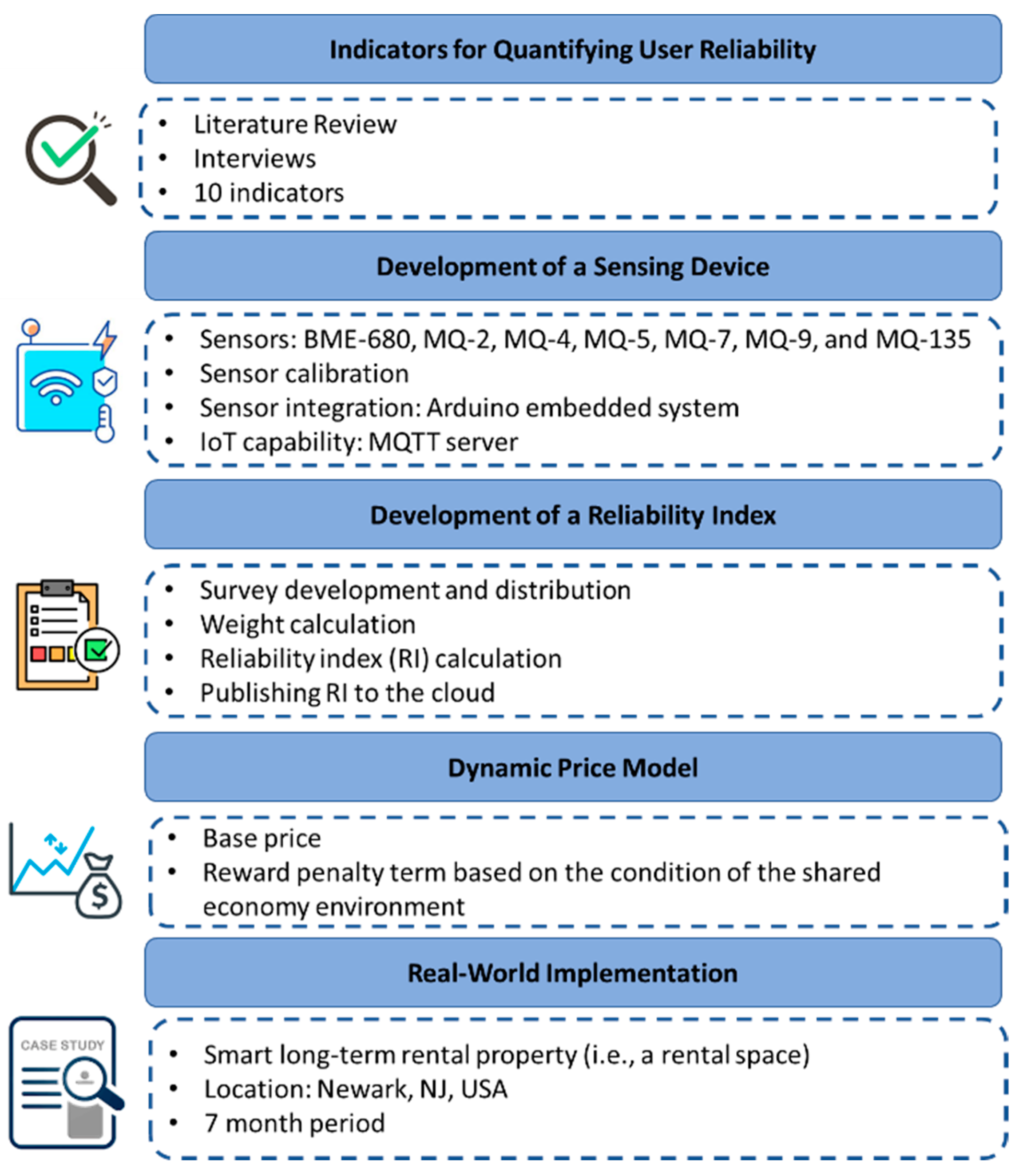
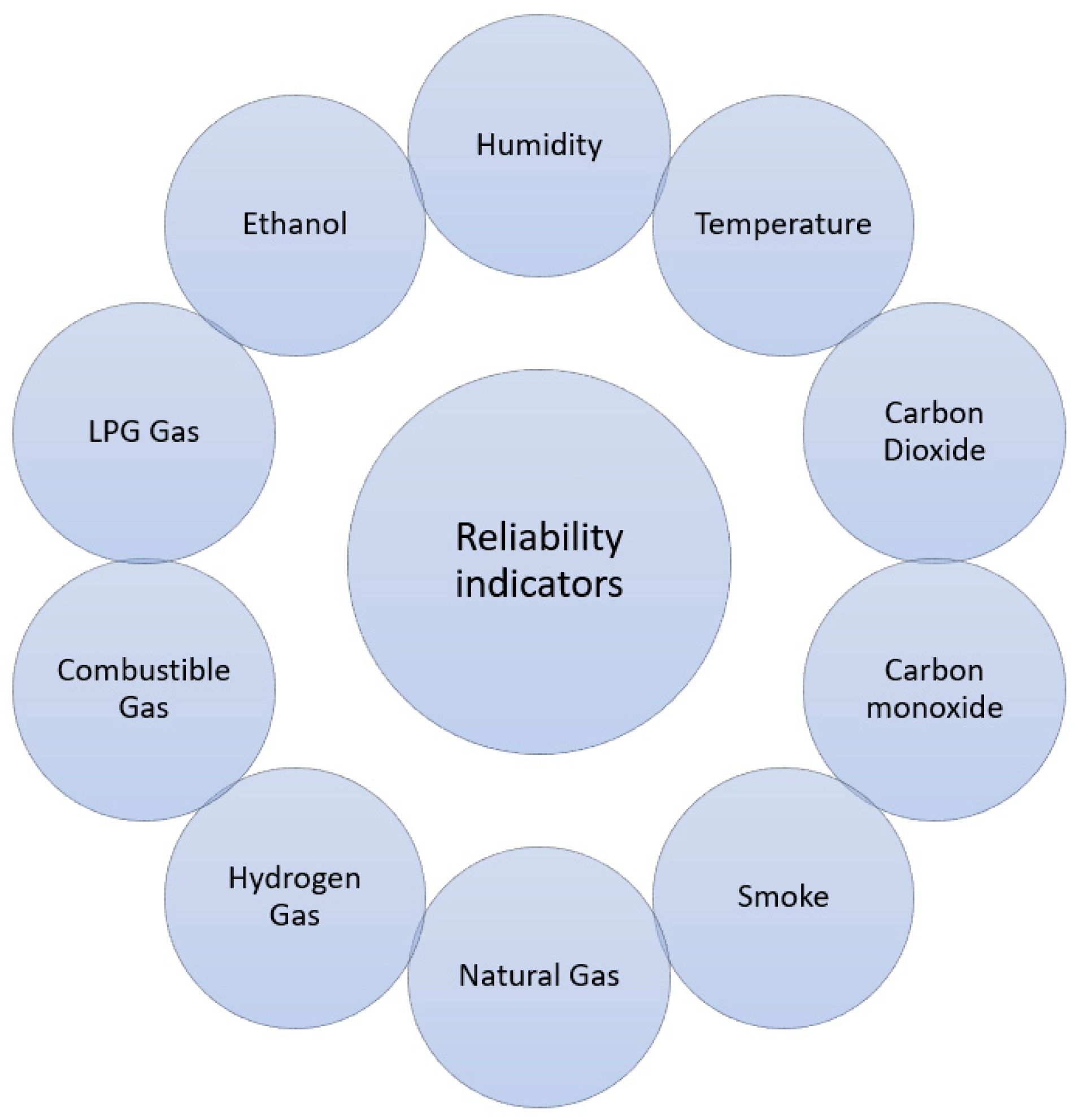
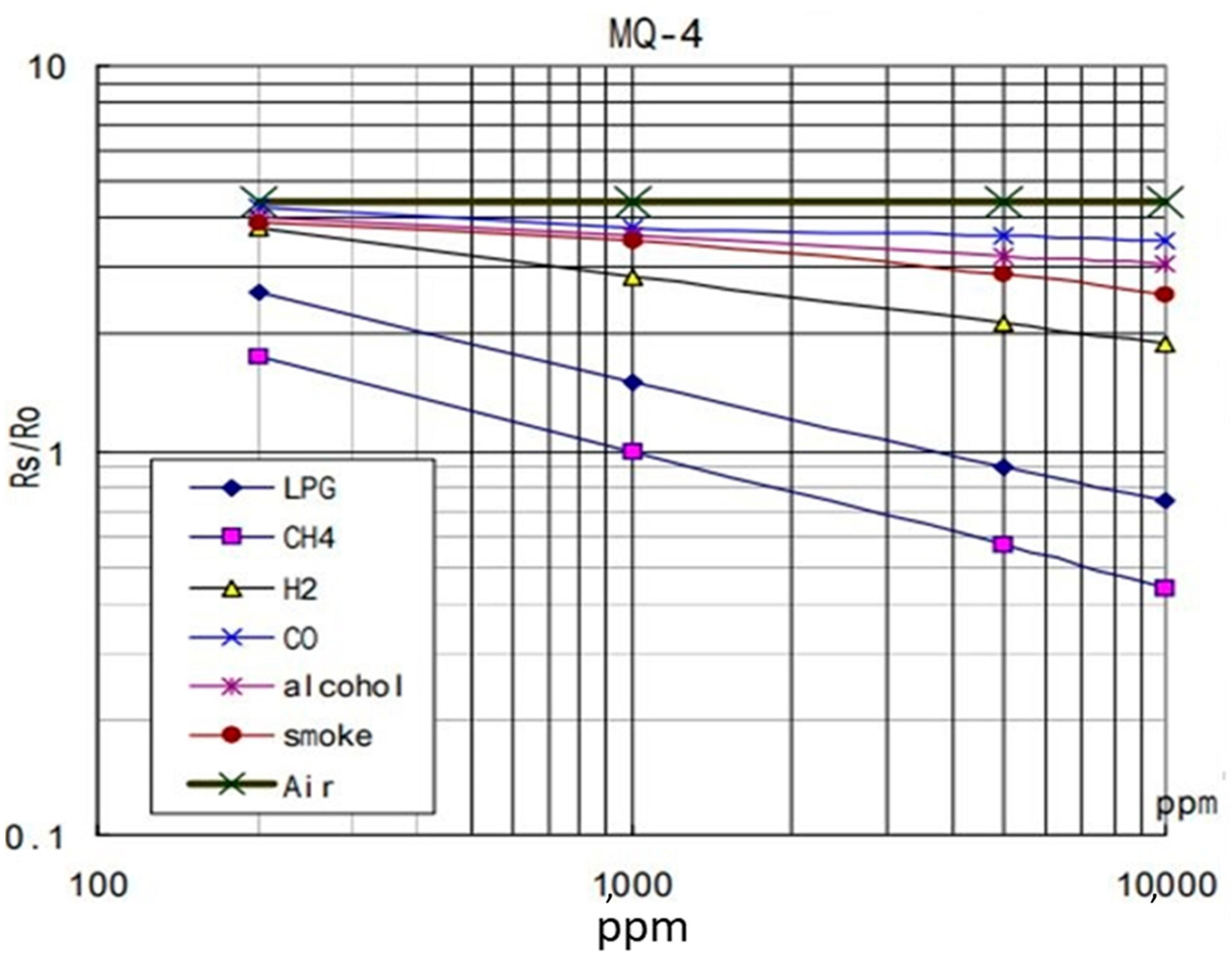
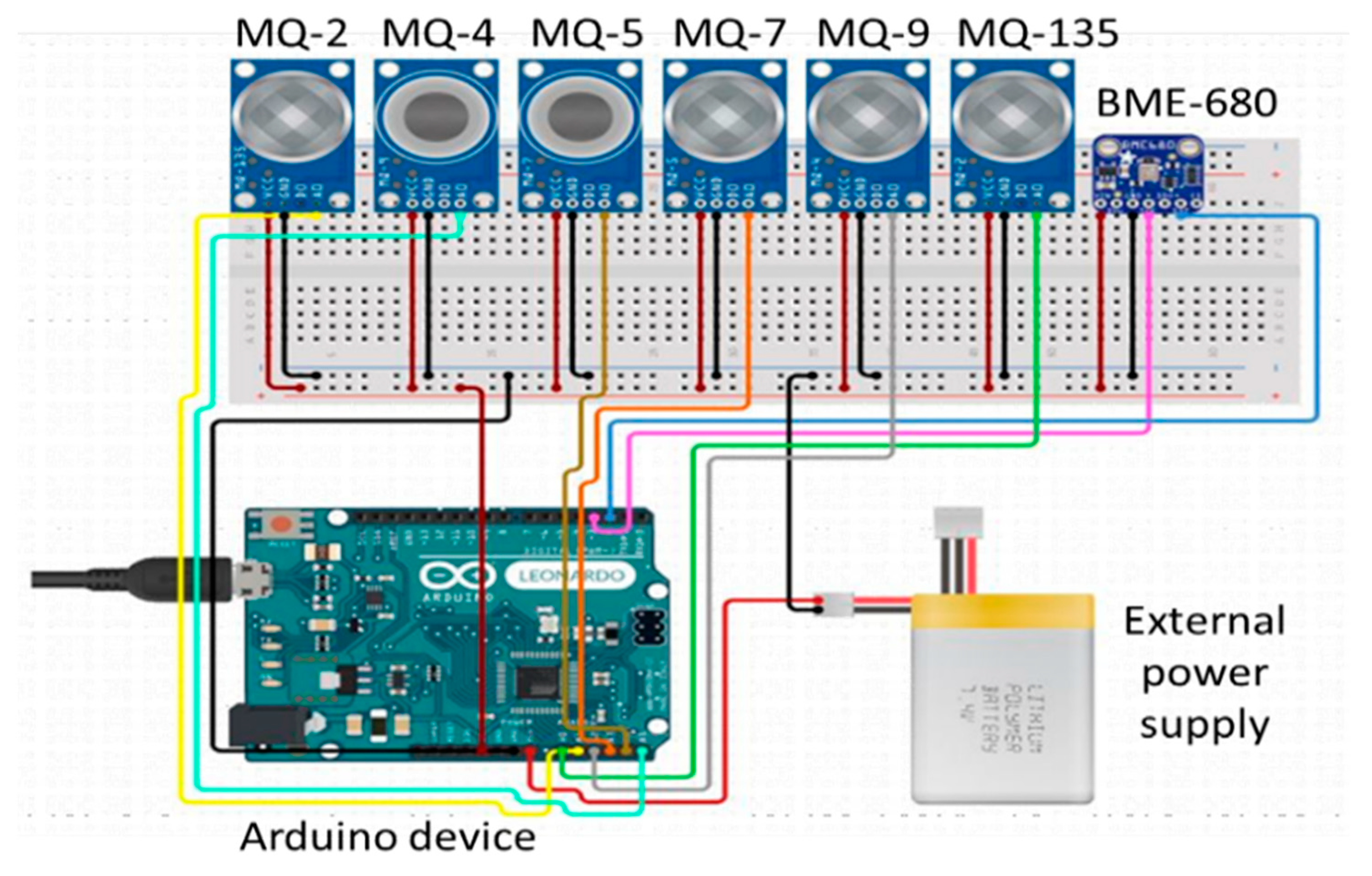
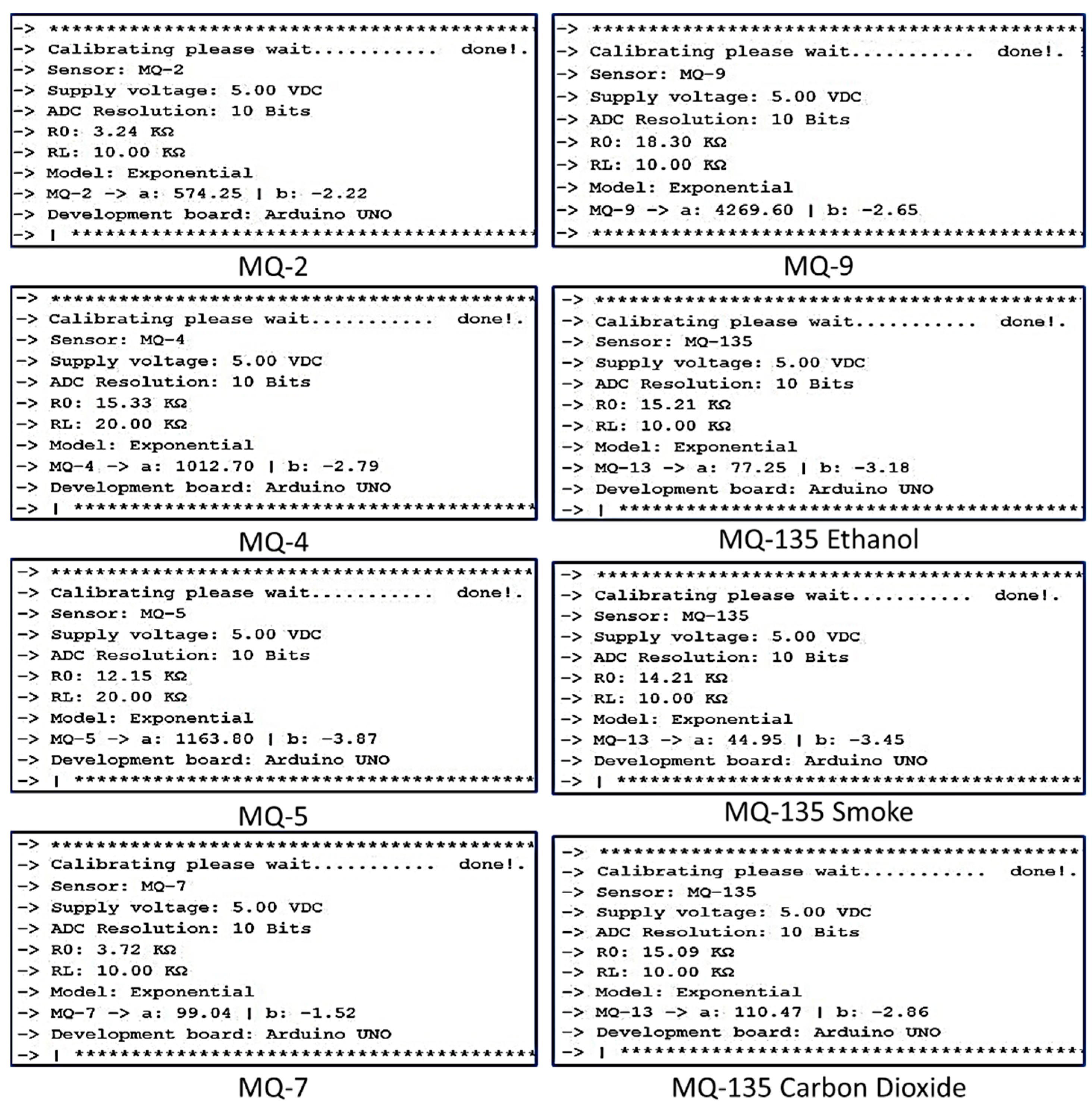
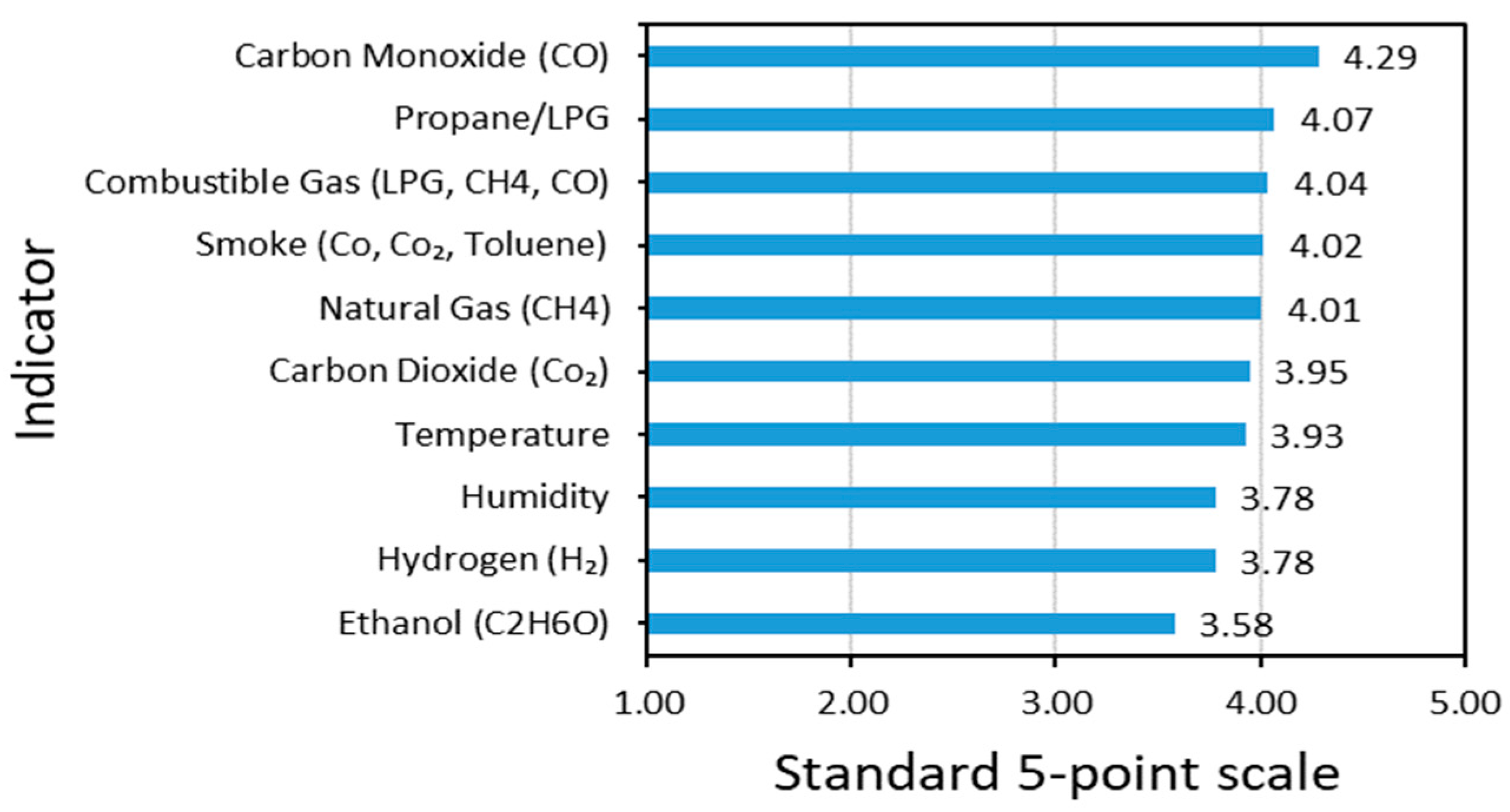
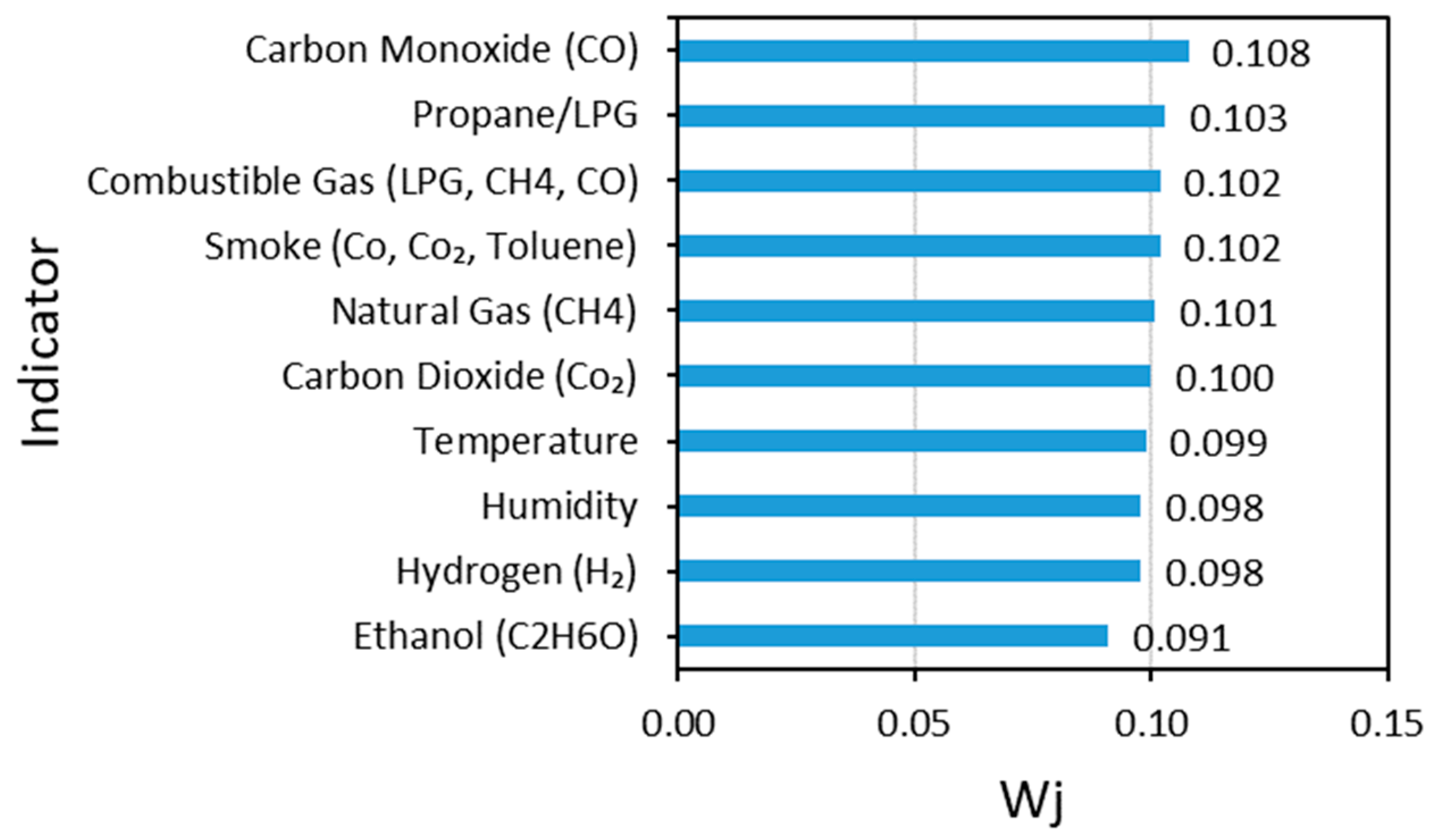
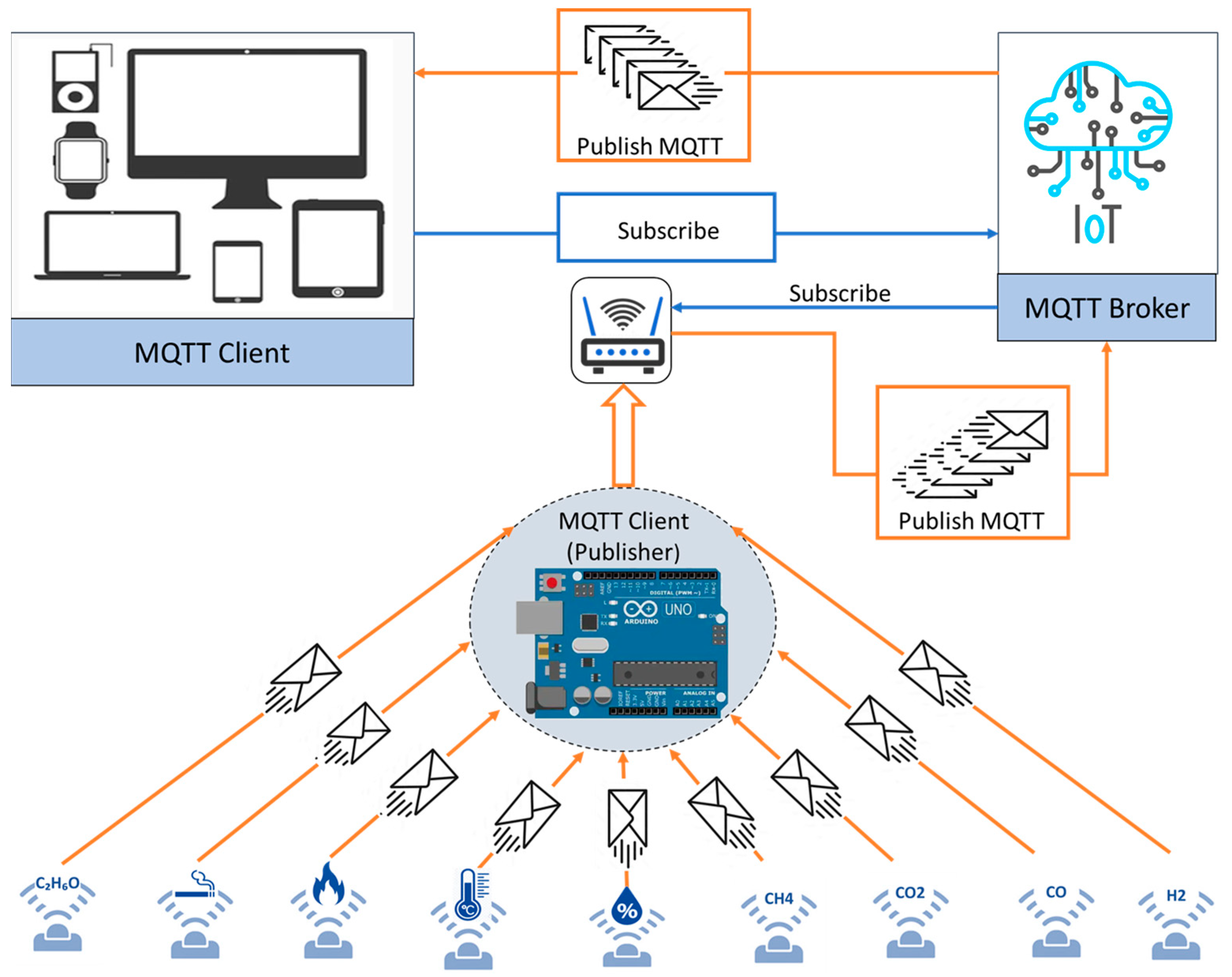
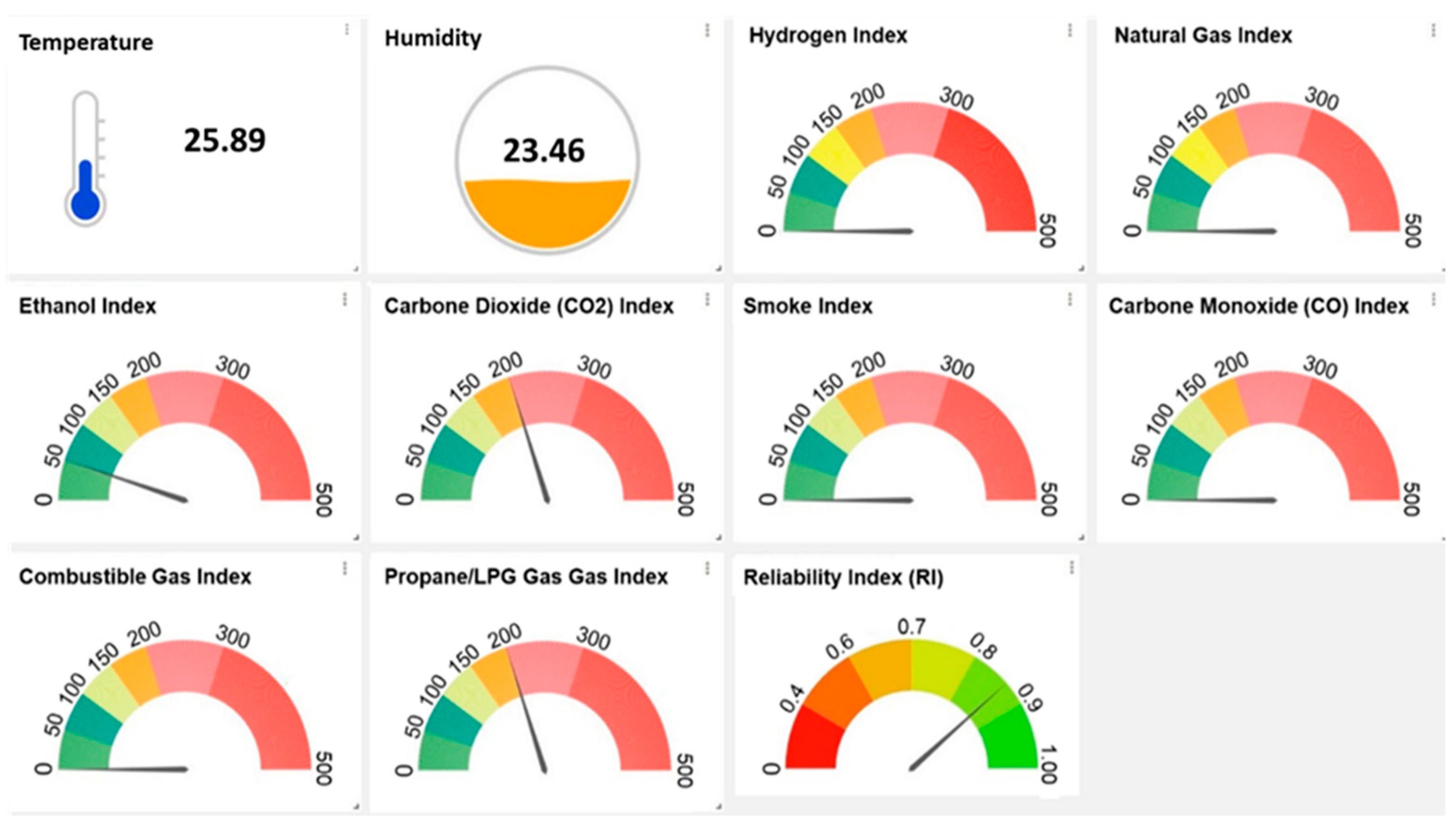
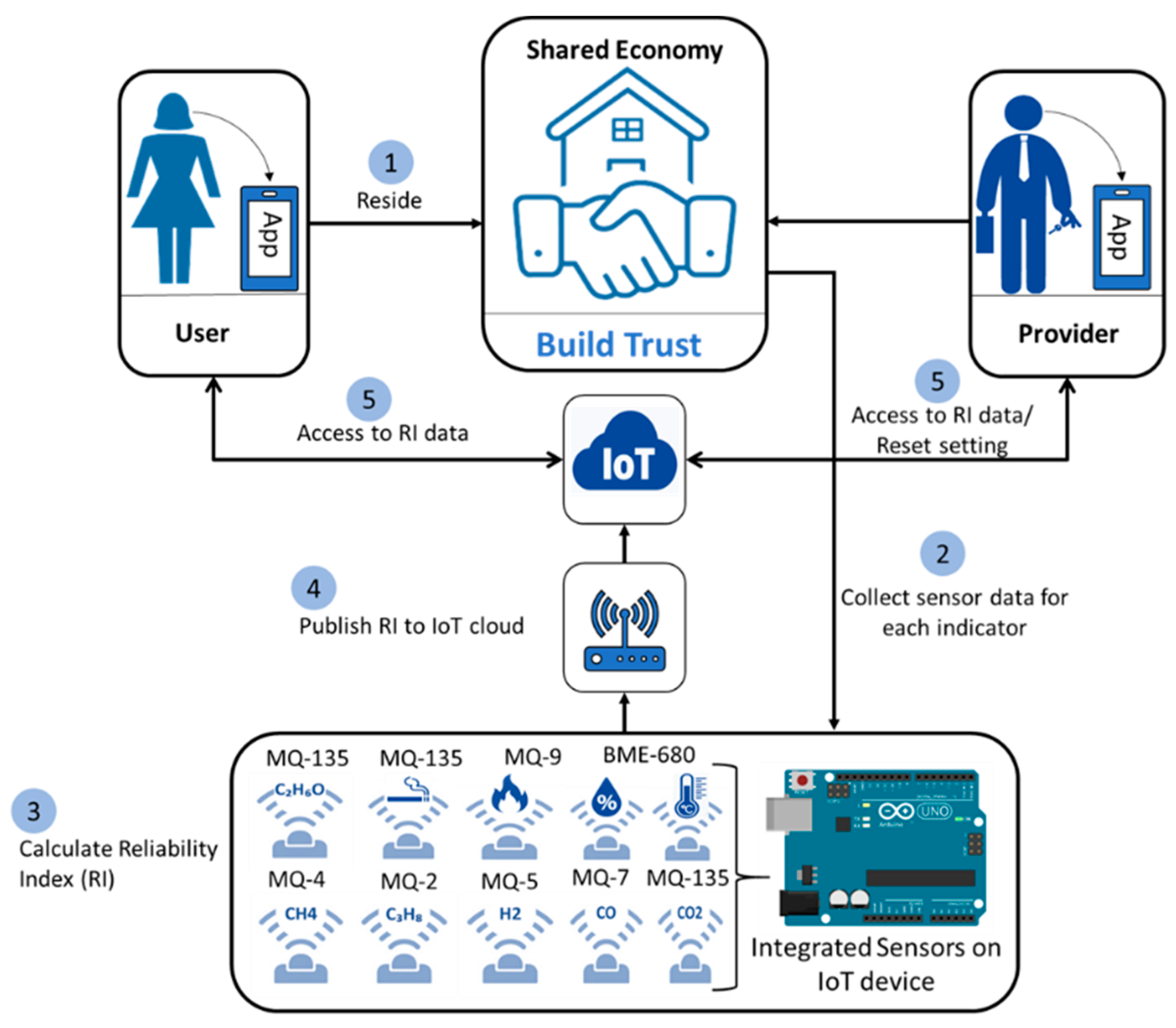
| Indicator | Excellent | Good | Fair | Poor | Bad | Very Bad | References |
|---|---|---|---|---|---|---|---|
| Temperature (°C) | 19–21 | 21–27 | 27–30 | 30–32 or 13–18 | 32–35 or 9–13 | >35 or <9 | [71,72] |
| Humidity (%) | 30–50 | 50–60 | 60–70 | 70–80 or 20–30 | 80–90 or 10–20 | >90 or <10 | [73] |
| LPG (ppm) | 0–100 | 100–250 | 250–800 | 800–1000 | 1000–2000 | >2000 | [74,75,76,77,78] |
| Natural Gas (ppm) | 0–100 | 100–200 | 200–800 | 800–1000 | 1000–2000 | >2000 | [79,80,81] |
| Hydrogen (ppm) | 0–170 | 170–300 | 300–700 | 700–1000 | 1000–2000 | >2000 | [82] |
| Carbon Monoxide (CO) (ppm) | 0–35 | 35–50 | 50–100 | 100–400 | 400–1200 | >1200 | [83,84,85] |
| Combustible Gas (ppm) | 0–100 | 100–250 | 250–800 | 800–1000 | 1000–2100 | >2100 | [76,86,87] |
| Ethanol (ppm) | 0–40 | 40–100 | 100–200 | 200–400 | 400–500 | >500 | [88,89,90] |
| Smoke (ppm) | 0–100 | 100–200 | 200–300 | 300–500 | 500–600 | >600 | [91] |
| Carbon Dioxide (CO2) (ppm) | 0–400 | 400–500 | 500–600 | 600–800 | 800–1000 | >1000 | [92] |
| Sensor | Detected Indicator | () | Constant a | Constant b |
|---|---|---|---|---|
| MQ2 | LPG | 9.83 | 658.71 | −2.168 |
| MQ4 | Natural Gas | 4.4 | 1012.70 | −2.786 |
| MQ5 | Hydrogen | 6.5 | 1163.80 | −3.874 |
| MQ7 | Carbon Monoxide | 27.5 | 99.04 | −1.518 |
| MQ9 | Combustible Gas | 9.6 | 4269.60 | −2.648 |
| MQ135 | Ethanol | 3.6 | 77.26 | −3.180 |
| MQ135 | Smoke | 3.6 | 44.95 | −3.445 |
| MQ135 | Carbon Dioxide | 3.6 | 110.47 | −2.862 |
| ILo | IHi | Condition |
|---|---|---|
| 0 | 49.99 | Excellent |
| 50 | 99.99 | Good |
| 100 | 149.99 | Fair |
| 150 | 199.99 | Poor |
| 200 | 299.99 | Bad |
| 300 | 500 | Very Bad |
| RI Value | Description of RI | Reward/Penalty (i.e., RP Term) |
|---|---|---|
| [0.90, 1.00] | Excellent | −15% |
| [0.80, 0.90] | Good | −10% |
| [0.70, 0.80] | Fair | 0% |
| [0.60, 0.70] | Poor | +10% |
| [0.40, 0.60] | Bad | +15% |
| [0.00, 0.40] | Very Bad | +20% |
| Month () | Base Rent () (USD) | Dynamic Price () (USD) | ||
|---|---|---|---|---|
| 1 | 900 | 0.69 | 0.00 | 900 |
| 2 | 900 | 0.71 | 0.00 | 900 |
| 3 | 900 | 0.81 | −10% | 810 |
| 4 | 900 | 0.81 | −10% | 810 |
| 5 | 900 | 0.85 | −10% | 810 |
| 6 | 900 | 0.89 | −10% | 810 |
| 7 | 900 | 0.62 | 10% | 990 |
Disclaimer/Publisher’s Note: The statements, opinions and data contained in all publications are solely those of the individual author(s) and contributor(s) and not of MDPI and/or the editor(s). MDPI and/or the editor(s) disclaim responsibility for any injury to people or property resulting from any ideas, methods, instructions or products referred to in the content. |
© 2023 by the authors. Licensee MDPI, Basel, Switzerland. This article is an open access article distributed under the terms and conditions of the Creative Commons Attribution (CC BY) license (https://creativecommons.org/licenses/by/4.0/).
Share and Cite
H. Assaad, R.; Mohammadi, M.; Chang, A. An IoT-Enabled Sensing Device to Quantify the Reliability of Shared Economy Systems Using Intelligent Sensor Fusion Building Technologies. Buildings 2023, 13, 2182. https://doi.org/10.3390/buildings13092182
H. Assaad R, Mohammadi M, Chang A. An IoT-Enabled Sensing Device to Quantify the Reliability of Shared Economy Systems Using Intelligent Sensor Fusion Building Technologies. Buildings. 2023; 13(9):2182. https://doi.org/10.3390/buildings13092182
Chicago/Turabian StyleH. Assaad, Rayan, Mohsen Mohammadi, and Aichih (Jasmine) Chang. 2023. "An IoT-Enabled Sensing Device to Quantify the Reliability of Shared Economy Systems Using Intelligent Sensor Fusion Building Technologies" Buildings 13, no. 9: 2182. https://doi.org/10.3390/buildings13092182
APA StyleH. Assaad, R., Mohammadi, M., & Chang, A. (2023). An IoT-Enabled Sensing Device to Quantify the Reliability of Shared Economy Systems Using Intelligent Sensor Fusion Building Technologies. Buildings, 13(9), 2182. https://doi.org/10.3390/buildings13092182








